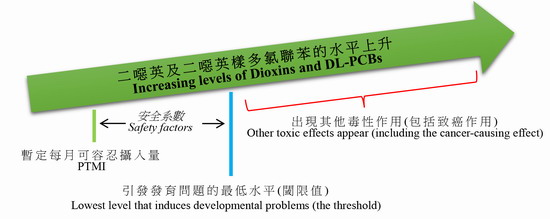
 |
  |
Food Safety Focus (124th Issue, November 2016) – Food Safety Platform
Dioxins and Dioxin-like Polychlorinated Biphenyls – What are They?
Reported by Mr. Johnny CHU, Scientific Officer,
Risk Assessment Section,
Centre for Food Safety
What are Dioxins and Dioxin-like Polychlorinated Biphenyls (DL-PCBs)?
Dioxins and DL-PCBs refer to a group of environmental persistent chemicals with similar toxicological properties. Dioxins are produced as unwanted by-products of combustion (e.g. waste incineration) and some industrial processes (e.g. bleaching paper pulp using chlorine). Natural disasters such as forest fires and volcanic eruptions can also release dioxins. In contrast, polychlorinated biphenyls (PCBs) were manufactured in the past for a variety of industrial uses such as electrical insulators, lubricants, plasticisers, and specialised hydraulic fluids.
Dioxins and DL-PCBs are found throughout the world in the environment; however, their levels in the environment have been declining during the last two decades due to the prohibition of production and use of PCBs in most countries since 1970s and the improved technology of waste incineration with low dioxin emissions.
How do Dioxins and DL-PCBs Contaminate Food?
Dioxins and DL-PCBs are not soluble in water and highly resistant to degradation. Once released, they contaminate soil surfaces and aquatic sediments leading to bioaccumulation and biomagnification (i.e. increasing concentration) of the contaminants through the food chain. Since dioxins and DL-PCBs are fat-soluble, they accumulate in fatty tissues of animals. Hence, fatty foods such as meat, poultry, seafood and dairy products are the major dietary sources of dioxins and DL-PCBs in the general population. For aquatic animals, the body parts which naturally have a higher content of fat may also contain a higher amount of dioxins and DL-PCBs. For example, fish livers and brown meat (includes gonads, livers and digestive glands) of crabs are known to contain a higher amount of dioxins and DL-PCBs.
Long-term exposure to dioxins and DL-PCBs has been associated with a range of toxic effects on different parts of the human body, including impairment of the immune system, the endocrine system, the developing nervous system and the reproductive function. Dioxins and DL-PCBs can also cause cancer.
Health-based Guidance Value
Many non-genotoxic carcinogens (i.e. chemicals that induce cancers via a mechanism not involving direct damage to DNA) induce tumours as a result of another adverse toxic effect which has a threshold (i.e. a level below which no effect occurs). For these substances, exposure below the threshold poses no health risk, both cancer and other toxic effects. Dioxins and DL-PCBs are non-genotoxic carcinogens and belong to this category of substances.
The persistency of dioxins and DL-PCBs means that exposure to a small dose of these substances on a given day may have little or no impact on human health; however, long periods of exposure to small doses can have a cumulative adverse effect on human health. Hence, when assessing the long-term risk to human health of these substances, emphasis should be placed on assessing the cumulative total intake of these substances over a period of several months. The Joint FAO/WHO Expert Committee on Food Additives (JECFA) decided to express the tolerable intake for dioxins and DL-PCBs on a monthly basis in the form of a provisional tolerable monthly intake (PTMI) (see Fig). PTMI is an indicator that stresses on the ingestion of a toxic substance over a lifetime without appreciable risk to health. In other words, occasional short-term exposure above PTMI would have no health consequences.

Diagrammatic representation of the derivation of a provisional tolerable monthly intake (PTMI)
According to the results of the First Hong Kong Total Diet Study, the dietary exposures to dioxins and DL-PCBs for both the average and high consumers of the local population were below the PTMI set by JECFA, meaning that the local population is unlikely to experience major undesirable health effects of dioxins and DL-PCBs.
What can Consumers Do to Reduce Exposure to Dioxins and DL-PCBs from Food?
As dioxin and DL-PCBs accumulate in fats of animals, trimming fat from meat and consuming low fat dairy products may decrease the exposure. Also, a balanced diet (including adequate amounts of fruits, vegetables and cereals) will help to avoid excessive exposure from a single source. According to World Health Organization, this is a long-term strategy to reduce body burdens (levels in the body) and is probably most relevant for girls and young women to reduce exposure of the developing fetus and when breastfeeding infants later on in life.